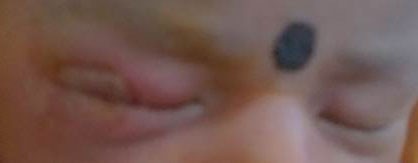

Strabismus, also known as crossed eyes, is a condition in which the eyes do not properly align with each other when looking at an object. The eye which is focused on an object can alternate.The condition may be present occasionally or constantly. If present during a large part of childhood, it may result in amblyopia or loss of depth perception.
Pediatric ophthalmologists treat all eye problems in children under the age of 15 years. As strabismus is one of the common problems in children, pediatric ophthalmologists are trained to treat strabismus in children and adults. A child should not be regarded as a small adult. Children have unique needs and concerns. An incorrect treatment decision or a delayed treatment could result in a permanent impairment of vision. Children do not volunteer complaints, and may not give a reliable history. Many a time they would not cooperate for an exam either. There are special techniques to assess vision in children. Special hand held instruments are needed to examine very young children. A child friendly atmosphere is also required in the examination area to win the confidence of children. A play area and a feeding room for babies are an integral part of a pediatric ophthalmology unit.
We can divide the eye problems in children into two categories – the serious ones and the ones that are common and not so serious. Let us discuss the serious ones first.



What's a latent squint ?
A latent squint is a type of squint that only occurs when one eye is covered or closed. There’s no squint when your eyes are open and being used.
Latent squints are common; most people have one to a mild degree. It may be noticed when you’re daydreaming, or gazing into the distance.
If you’ve had your eyes tested by an optician you may remember a test where they alternately cover one eye then the other. They watch your eyes carefully to see if they move when the cover is removed. This is called an alternating cover test, and it’s designed to pick up a latent squint if you have one.
Will my child grow out of their squint ?
No, your child won’t grow out of their squint and will need treatment to straighten their eye. If left untreated, a squint can cause permanent damage to eyesight. For more information, see our section: Complications of squint above, which talks about problems with developing binocular vision, and getting a lazy eye (amblyopia).
It’s important to get treatment for a lazy eye as soon as possible. Treatment to straighten the eye is less urgent. Ideally, treatment of lazy eye should happen before the age of seven, although some older children may still see some improvement in their vision with treatment. In general, the sooner treatment starts, the more your child will benefit.
Your child’s orthoptist or ophthalmologist will discuss with you the best time for any treatments they recommend for your child.
My new baby has a squint - what should I do ?
It's quite common for newborn babies to have a squint from time to time. This is usually nothing to be concerned about and will disappear within the first few months of life. However, if the squint is there all the time, or is still there when your infant is over three months old, talk to your optician or GP.
If you ever notice that your baby’s pupil seems white, even just in a photograph, see your GP or an optician right away. For more information, see our section: Symptoms of squint.
Can a squint be treated in adults ?
If you develop a squint as an adult, you’ll probably notice the change in the way your eyes look in the mirror. You may get double vision, and your eyes may feel uncomfortable – as though you have eye strain.
If you have a squint as an adult, there’s a good chance that you’ll benefit from treatment. Treatments include glasses, prisms, eye exercises, botulinum toxin and surgery. Treatment can improve the way you look, and may also improve your binocular vision and help reduce double vision.
As many as four in 100 adults have a squint. You may have had it since childhood or it may have developed later.
Treatment of your squint may help reduce symptoms of double vision if these affect you. And, although binocular vision develops during early childhood, some adults may still get some improvement in their binocular vision with treatment.
You may want treatment for your squint because of the way you look. People with a squint often say it affects their self-esteem, social life and even their job prospects.